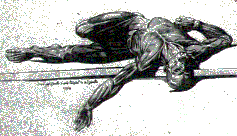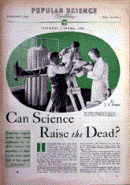|
what 1800's scientific discoveries could have created mary shelleys
monster?
im doing a research paper on science during the eighteen hundreds. this of
course can be written with simple facts, however,(and i hope youve read
frankenstein) what methode could have been used to create the monster with
the technology of the time? its quite an interesting question to me. i
thought i would get some feedback from you guys on this. thanks alot! |

|
|
Untitled, 1779 J.F. Declassan illustration from Jacques Gamelin, Nouveau Recueil d'Osteologie et de Myologie, 1779 |
There are no methods that could have been used to create Victor Frankenstein's monster either then or now. Frankenstein, or the Modern Prometheus is a work of science fiction; like all good science fiction, it makes a plausible extrapolation from what is known and uses that extrapolation to set the scene. Mary Shelley's novel, again like most good science fiction, had much more to do with human emotions and interactions than with the science or technology used to set the scene.
 Frankenstein extrapolated from
Frankenstein extrapolated from
- Galvani's experiments, in which dead animals and parts of animals were induced to move by the application of electricity.
- Advances in artificial respiration, by which drowning victims could be "brought back to life." Sometimes jolts of electricity were used to revive a victim.
- Widespread belief among scientists and physicians that life could arise spontaneously from dead matter (spontaneous generation) and that it might be possible to resuscitate corpses. This was considered a serious possibility by some as late as the 1930s.
Note, though, that Shelley never attempted to explain how Frankenstein brought life to his laboriously-assembled conglomeration of graveyard-meat. This was for very good reason: it would not only have destroyed the flow of the tale, but might have made it almost impossible for the reader to suspend disbelief so that she could develop the creature's character.
More information can be found at
- The Frankenstein home page at the National Library of Medicine is comprehensive and covers most aspects of your question. Art in this answer is taken from that site.
- Resources for the study of Mary Shelley's Frankenstein, including electronic text editions and other links.
- A Google search will turn up a lot more information, mostly on the novel itself and dramatic adaptations.
| Dan Berger |
| Bluffton College |
| http://cs.bluffton.edu/~berger |